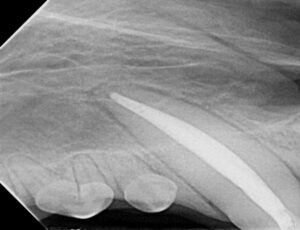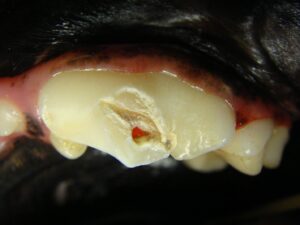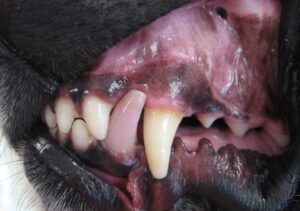
29 Sep WANTED: Fractured Teeth, Dead or Alive!
One of the most common reasons why dog and cat owners call us is to ask about fractured teeth. Dogs can fracture teeth chewing on a kennel door, playing with a friend, or even chewing on a hard object. Cats are so good at keeping secrets that we often don’t know how they fractured a tooth. Any fractured teeth in dogs or cats should be examined more closely, even if your pet is acting fine.
Is a fractured tooth an emergency?
Yes and no. If you have a very young dog or cat (under 18 months of age), then a fractured tooth with pulp exposure can be a true emergency. The root is still developing in very young animals, so the clock is ticking if you want to save the tooth. The goal is to keep the tooth alive so that the root can continue to grow and the tooth can become sturdier. If the tooth is treated within 48 hours, a procedure called “vital pulp therapy” can be performed. A tiny amount of pulp is removed and replaced with MTA, a material that tells the pulp to stay alive and keep making dentin. A hard-filling material is used to cover the MTA. In 6 months, we can see that the tooth is continuing to mature and usually the pulp builds a brand-new layer of dentin between itself and the MTA. Vital pulp therapy can be performed on older animals if the fracture is less than 48 hours old and the animal is under 6 years of age. Vital pulp therapy can last for the rest of the animal’s life, but the tooth should be re-evaluated regularly.
When can root canal treatment be performed?
If a fracture is more than 48 hours old, root canal treatment can be performed to save the tooth. Root canal treatment involves removing the pulp entirely, cleaning out the inside of the tooth, filling it up and sealing it off so that the tooth cannot get infected. Some teeth cannot be saved this way for a variety of factors including the pet’s age, length of time that the pulp has been exposed, extent of damage to the crown, periodontal health of the tooth and anatomical factors. Recently fractured teeth still have some pulp left and it bleeds during the procedure. If the bleeding cannot be controlled, then a temporary filling is placed and the pet returns at another time to complete treatment. Most pet insurance plans will cover either vital pulp or root canal treatment, but always check your policy to be sure.

Dental x-ray of a right upper canine after root canal treatment
How do you know if the pulp is exposed?
The pulp is the tissue in the center of the tooth. It contains nerves that can only sense one thing- PAIN! Tooth pulp is very sensitive. If you happen to be watching your pet when a tooth breaks, the animal will often shake their head, smack their lips, drool and may even bleed from the mouth. Within a day or so, your pet may act like nothing happened as the superficial layer of pulp starts to die. Eventually, all the pulp dies, and the tooth may not be sensitive until it becomes infected. If you look at the fractured surface of the tooth, the area of pulp exposure will look red, then pink, and finally black once the pulp is completely dead.

Pulp exposure on a fractured upper fourth premolar
What if the pulp is not directly exposed?
In cats, almost all fractures will expose the pulp due to the internal anatomy of the cat’s tooth. In dogs, especially as they get older, the dentin is thick enough that a fracture may not expose the pulp directly. Although dentin is hard and white, it is porous. The pulp can feel things (temperature, pressure, etc) through the dentin. Bacteria are small enough to penetrate the dentin. All fractured teeth should be evaluated under anesthesia. At Animal Dental Care & Oral Surgery we use advanced diagnostics including magnification, probing with endodontic files, and imaging with cone beam CT to determine if the pulp is exposed. If not, a bonded sealant can be used to protect the dentin. Treated teeth should be re-evaluated on a regular basis to be sure they remain vital.
What are dead teeth and how can they be treated?
What about dead teeth? A dead tooth is one where the pulp cells have died. This always happens with direct pulp exposure, but it can also happen because of trauma. Even if a force does not break the tooth, it can cause the pulp to die. If a tooth is discolored (pink, purple, gray or off-white), it almost always has a dead pulp. Some teeth die without discoloration. In most cases, dead teeth can be saved by root canal treatment.

Discolored left lower canine tooth
Is treatment for fractured teeth or dead teeth necessary?
What if I just wait and see? Fractured and dead teeth are magnets for bacteria. Infection and inflammation create a tooth root abscess. This causes bone loss around the tip of the root. Ask anyone who has ever had a tooth abscess, it is very painful! Left untreated, a tooth abscess can destroy the surrounding bone and rupture through the skin or soft tissue inside the mouth. By the time you can see this with your eyes, your pet has been in pain for a long time. Either root canal treatment or extraction can be used to treat a fractured tooth. The only wrong choice is to do nothing!
Image by Pavellllllll from Pixabay



